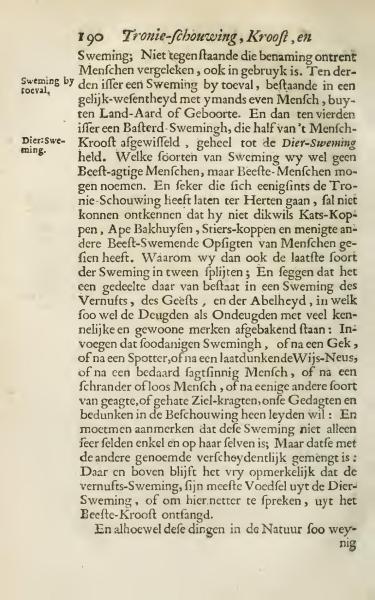190 Study of Features, Offspring, and
Immersion; Despite this denomination being commonly used,
and also applied to humans. Thirdly, there is an incidental resemblance,
consisting in a likeness with a person, outside of the country or birth.
And then fourthly, there is a hybrid likeness, which is partly human
but completely of animal resemblance. These types of resemblance we
do not typically call beast-like humans, but rather human-beasts.
And indeed, those who have somewhat contemplated the Study of Features
cannot deny that they have often seen Cat-like heads, Ape Chests,
Bull-heads, and a multitude of other beast-like appearances in humans.
Therefore, we would also divide the last kind of likeness into two;
And say that one part comprises a resemblance of intellect,
spirit, and fertility, where virtues and vices are marked:
So that such likeness, whether of a Fool,
or a Jester, or a disdainful Wise-noser;
or a composed calm person, or a clever
or foolish person, or any other kind
of respected or hated mental capacity or thoughts,
and intentions may be applied in study: And
we must note that this likeness is not
usually single or by itself; But that it is mixed
distinctively with others mentioned:
Moreover, it remains quite remarkable that intellectual resonance
gets most of its nourishment from animal resemblance,
or to speak more neatly, draws from the beastly offspring.
And although these matters in nature are so scantily
Translation Notes:
- 'Sweming' is used here to mean a likeness or resemblance.
- 'Tronie-schouwing' refers to the study or observation of facial features or expressions.
- 'Basterd-Swemingh' might refer to what we now understand as hybrid features or expressions.
The text discusses different kinds of facial resemblance and likenesses, contrasting them between human and animal traits. It describes accidental and hybrid resemblances, noting how certain animal-like features can be perceived in humans. The text also delves into the intellectual aspect of these likenesses and how they may combine or stand uniquely in nature.
